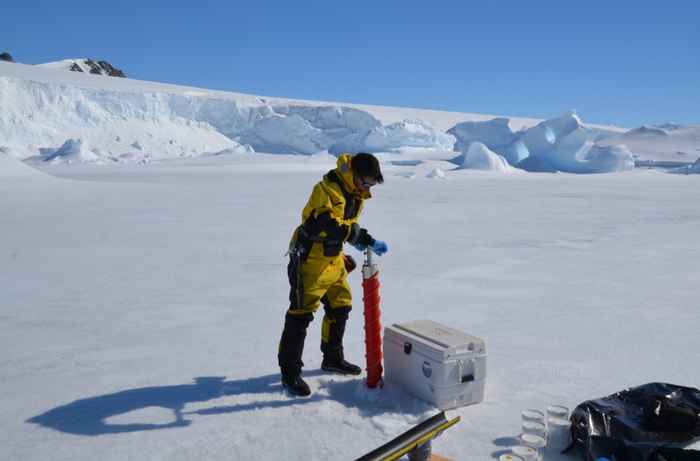Study in Antarctica may shed light on how micro-algae help regulate the climate
8 July 2024

Together with researchers from the University of Groningen, they receive funding from the Netherlands Polar Programme (NPP).
Thriving on winter food
Like higher plants, microalgae are photoautotrophic: through photosynthesis, they bind carbon from the air using energy from sunlight. Many micro-algae in the frigid sea off Antarctica can also live in a more 'animal-like' way: they eat other algae and organic material dissolved in seawater.
"This so-called mixotrophic lifestyle might help the microalgae survive the pitch-dark polar winter and spring," says Susanne Wilken, ecological researcher at the Institute for Biodiversity and Ecosystem Dynamics (IBED) at the UvA. "Probably that winter food gives the microalgae a kickstart in the new season to get ahead of the other algae."

Anti-freeze results in cloud formation
Microalgae around Antarctica have yet another unique trait: they bind sulphur by producing the substance DMSP, dimethylsulphoniopropionate. Wilken: "For the micro-algae, the DMSP actually acts as a salt regulator and anti-freeze, helping them survive in the sea ice. Once the ice melts they get rid of the DMSP, and the breakdown product DMS is a gas that can enter the atmosphere. There, it stimulates cloud formation, blocking sunlight. So, by degrading their anti-freeze after use, microalgae indirectly have an important role in regulating climate."
Relationship between eating style of algae and climate change
Wilken is now curious about the relationship between the microalgae's mixotrophic lifestyle and the organisms' role in global carbon and sulphur cycles, an important factor in climate change. "Precisely because both mixotrophy and their sulphur-containing anti-freeze help microalgae survive in polar ice, we expect there to be a strong relationship between the two." In this NPP-funded project, Wilken is cooperating with the mass spectrometrist Gertjan Kramer from the Swammerdam Institute for Life Sciences (SILS) at UvA and with phytoplankton ecophysiologist Jacqueline Stefels from the University of Groningen. There is also cooperation with researchers from the British Antarctic Survey.
To unravel that relationship between the food of microalgae and climate regulation, the scientists will conduct research in the waters and sea-ice around Antarctica over the next five years, among others. They are using the Dutch Dirck Gerritsz Laboratory, which is based at Rothera research station maintained by the British Antarctic Survey. In two spring seasons, off the western Antarctic Peninsula, they will measure what part in the growth of microalgae comes from photosynthesis and what part comes from feeding on organic matter.
The scientists will also do controlled laboratory studies. Kramer: "By proteomics, which means studying the wide set of proteins that an organism produces, we will establish the interaction between the mixotrophic lifestyle and DMS production, while we also investigate the contribution of mixotrophic organisms to biogeochemical cycles and DMS concentrations in the atmosphere."
Warning against climate effects
But the advantage for mixotrophic micro-algae over other algae that cannot grow in sea ice in winter, exists only as long as there is enough winter sea ice. Last year, the extent of the Antarctic sea-ice has been lower than ever recorded before in our time, using satellites. A changing amount of sea ice will affect the growth of microalgae in the future. Wilken: "The results of the research project may therefore provide insight into how melting sea ice cancels out the cooling effect of microalgae on the climate. It may warn us against the accelerating consequences of climate change."